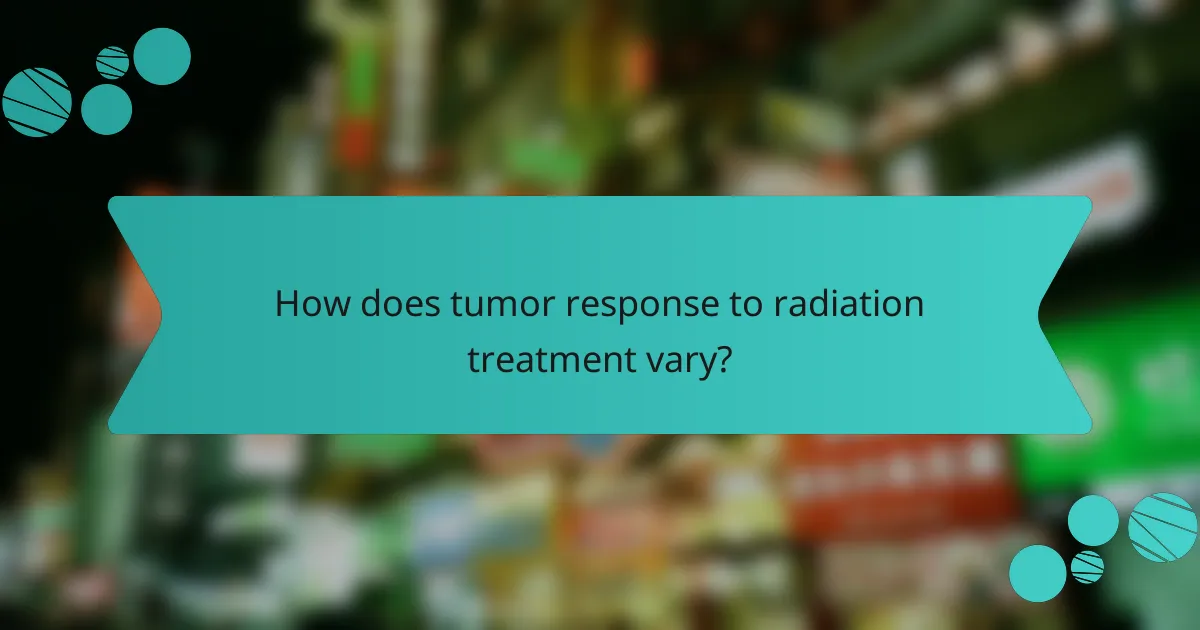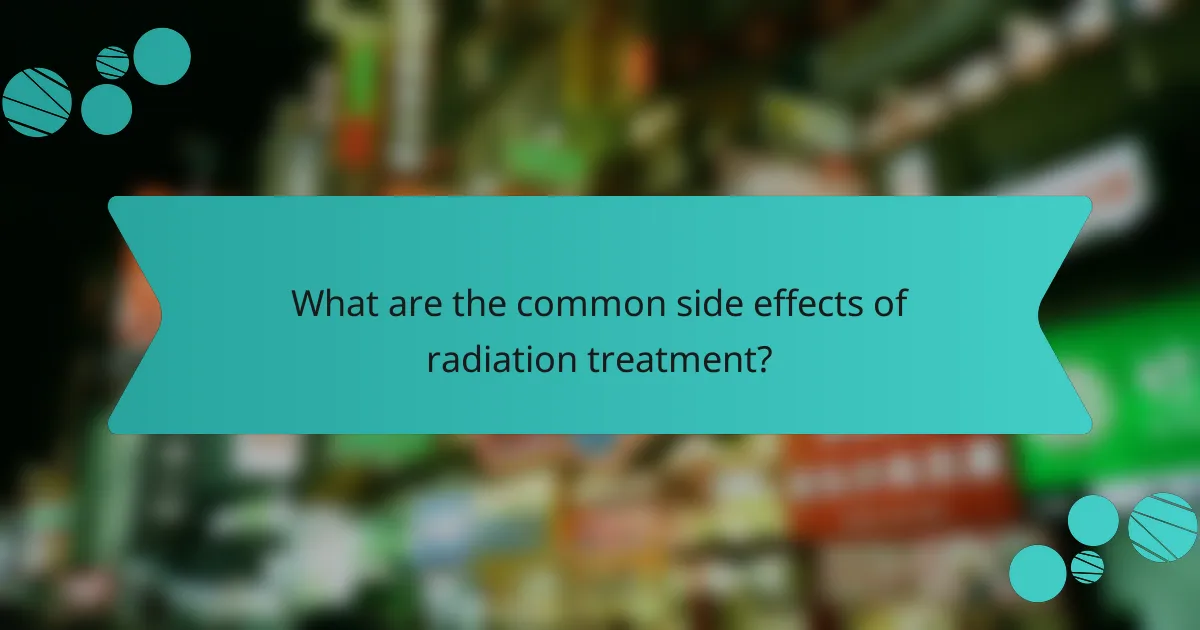Radiation treatment is a vital component in the management of tumors, utilizing methods such as external beam radiation therapy, brachytherapy, and radioisotope therapy tailored to patient needs. The response to treatment can vary significantly based on tumor characteristics, necessitating personalized approaches to optimize outcomes. Additionally, managing common side effects like skin reactions, fatigue, and nausea is crucial for enhancing patient comfort and quality of life during the treatment process.

What are the radiation treatment options in Canada?
In Canada, radiation treatment options primarily include external beam radiation therapy, brachytherapy, and radioisotope therapy. Each method has distinct applications, benefits, and considerations tailored to individual patient needs and tumor types.
External beam radiation therapy
External beam radiation therapy (EBRT) involves directing high-energy beams, such as X-rays or protons, at the tumor from outside the body. This method is commonly used for various cancers and is often delivered in multiple sessions over several weeks.
Patients typically undergo a planning session to determine the precise angles and doses required. It’s crucial to follow the treatment schedule closely to maximize effectiveness while minimizing damage to surrounding healthy tissue.
Brachytherapy
Brachytherapy delivers radiation directly to the tumor by placing radioactive sources inside or very close to the cancerous tissue. This approach allows for a higher dose of radiation to target the tumor while sparing more of the surrounding healthy tissue.
This treatment is often used for prostate, cervical, and breast cancers. Depending on the type, brachytherapy can be temporary or permanent, and its planning involves careful imaging and placement techniques.
Radioisotope therapy
Radioisotope therapy uses radioactive substances that can be administered orally or injected to target specific tumors, often in cases like thyroid cancer or certain types of bone metastases. This method allows for systemic treatment, reaching cancer cells throughout the body.
Patients should be aware of potential side effects, such as fatigue or changes in blood counts, and regular follow-up assessments are essential to monitor treatment response and manage any complications effectively.

How does tumor response to radiation treatment vary?
Tumor response to radiation treatment can differ significantly based on various factors, including tumor type, size, and location. Understanding these variations helps in tailoring effective treatment plans and managing expectations for outcomes.
Factors influencing tumor response
Additionally, the surrounding tissue and the tumor’s microenvironment play a crucial role. Tumors located in areas with better blood supply often respond more favorably to radiation due to improved oxygenation, which enhances the treatment’s effectiveness.
Types of tumors and response rates
Response rates can also be influenced by the stage of the cancer at diagnosis. Early-stage tumors generally respond better to radiation compared to advanced-stage tumors, which may require more aggressive treatment approaches.

What are the common side effects of radiation treatment?
Common side effects of radiation treatment include skin reactions, fatigue, and nausea. These effects can vary in intensity and duration depending on the treatment area and individual patient factors.
Skin reactions
Skin reactions are a frequent side effect of radiation therapy, often manifesting as redness, dryness, or peeling in the treated area. These reactions typically develop within a few weeks of starting treatment and may persist for some time after therapy concludes.
To manage skin reactions, keep the affected area clean and moisturized. Avoid tight clothing and harsh soaps, and consult your healthcare provider for recommended topical treatments.
Fatigue
Fatigue is another common side effect experienced by patients undergoing radiation treatment. It can range from mild tiredness to severe exhaustion, often worsening as treatment progresses.
To combat fatigue, prioritize rest and maintain a balanced diet. Light exercise, such as walking, can also help improve energy levels. It’s essential to listen to your body and adjust activities accordingly.
Nausea and vomiting
Nausea and vomiting may occur, particularly if radiation is directed at the abdomen or head and neck. These symptoms can arise shortly after treatment and may last for several hours or longer.
To manage nausea, consider eating small, frequent meals and avoiding strong odors. Your healthcare provider may prescribe anti-nausea medications if symptoms are severe. Staying hydrated is crucial, so drink plenty of fluids throughout the day.

How can side effects be managed during radiation therapy?
Managing side effects during radiation therapy involves a combination of medications, dietary changes, and supportive therapies. These strategies help alleviate discomfort and improve the overall treatment experience for patients.
Medications for symptom relief
Medications play a crucial role in managing side effects such as nausea, pain, and fatigue associated with radiation therapy. Common options include anti-nausea drugs like ondansetron and pain relievers such as acetaminophen or ibuprofen.
Patients should consult their healthcare provider to determine the most appropriate medications based on their specific symptoms and treatment plan. It’s essential to follow prescribed dosages and report any adverse reactions promptly.
Dietary adjustments
Dietary adjustments can significantly impact how patients feel during radiation therapy. Eating small, frequent meals that are easy to digest can help manage nausea and maintain energy levels. Foods rich in protein and calories are often recommended to support healing.
Staying hydrated is equally important; patients should aim for at least 8 cups of water daily unless otherwise directed by their healthcare team. Avoiding spicy, greasy, or overly sweet foods can also minimize gastrointestinal discomfort.
Supportive therapies
Supportive therapies, such as acupuncture, massage, and yoga, can enhance comfort and reduce stress during radiation treatment. These therapies may help alleviate pain, improve mood, and promote relaxation.
Patients should discuss these options with their healthcare team to ensure they complement their treatment plan. Joining support groups can also provide emotional support and practical tips from others undergoing similar experiences.

What follow-up assessments are recommended after radiation treatment?
After radiation treatment, follow-up assessments are crucial for monitoring tumor response and managing side effects. These assessments typically include imaging tests, physical examinations, and evaluations of patient-reported outcomes to ensure comprehensive care.
Imaging tests
Imaging tests are essential for evaluating the effectiveness of radiation therapy. Common modalities include CT scans, MRIs, and PET scans, which help visualize the tumor and surrounding tissues. These tests are usually scheduled a few months after treatment and may be repeated periodically based on the patient’s condition.
When undergoing imaging, it’s important to discuss with your healthcare provider how often these tests should occur. Generally, follow-up imaging may be done every three to six months during the first couple of years after treatment, depending on the tumor type and initial response.
Physical examinations
Regular physical examinations are a key component of post-radiation follow-up. During these visits, healthcare providers assess the patient’s overall health, check for any new symptoms, and monitor for potential side effects from the treatment. These examinations typically occur every few months initially, transitioning to less frequent visits as time progresses.
Patients should prepare for these exams by noting any changes in their health, including pain, fatigue, or other symptoms. Open communication with the healthcare provider during these visits can help address concerns promptly and adjust care as needed.
Patient-reported outcomes
Patient-reported outcomes (PROs) involve collecting information directly from patients about their health status and quality of life after radiation treatment. This can include assessments of pain levels, fatigue, emotional well-being, and overall satisfaction with care. PROs provide valuable insights that may not be captured through clinical assessments alone.
Incorporating PROs into follow-up care can help tailor treatment plans to better meet individual patient needs. Patients are encouraged to share their experiences and concerns during follow-up appointments to enhance their care and support ongoing health management.
